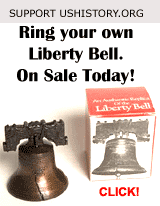Liberty Bell Facts
Location: Liberty Bell Center, Market Street & 6th, Philadelphia, Pennsylvania (Map of Historic Philadelphia)
Bell Originally Cast: Whitechapel Foundry 1752
Bell recast: Pass & Stow Philadelphia 1753 and again later that year
Bell owned by: The City of Philadelphia (not the Park Service)
Center opened: October, 2003
Center architect: Bernard J. Cywinski of Bohlin, Cywinski, Jackson
Exhibit designer: UJMN Architects + Designers (Ueland Junker McCauley Nicholson LLC)
Tourism information: Daily 9am-5pm with extended hours July and August. The bell is visible 24 hours a day. 215-597-8974
Strike note: E-flat
[Listen to the Normandy Liberty Bell]
Composition: 70% copper, 25% tin, small amounts of lead, zinc, arsenic, gold and silver (a more detailed analysis is given below.)
Size of "Crack": The "crack" is approximately 1/2 inch wide and 24.5 inches long. The Bell actually suffered a series of hairline cracks. The area around the crack was expanded in hopes of extending the useful life of the Bell. In the picture at right, note the hairline crack that finally rendered the bell unusable extending upward.
Bell Stats
- Circumference around the lip: 12 ft.
- Circumference around the crown: 7 ft. 6 in.
- Lip to crown: 3 ft.
- Height over the crown: 2 ft. 3 in.
- Thickness at lip: 3 in.
- Thickness at crown: 1-1/4 in.
- Weight (originally): 2080 lbs.
- Length of clapper: 3 ft. 2 in.
- Weight of clapper: 44-1/2 lbs.
- Weight of yoke: 200 lbs.
- Length of visible hairline fracture: approx. 2' 4" (this and next measurement made by Park curator Bob Giannini in 1993)
- Length of drilled crack: approx. 2' 1/2"
- Yoke wood: American Elm (a.k.a. slippery elm)
Detailed Analysis of the Bell's Composition
- Venerable Relic: The Story of the Liberty Bell by David Kimball, 1989, Eastern National Park & Monument Association, Philadelphia, PA
- Loud and Clear: The Story of Our Liberty Bell by Harold V.B. Boorhis and Ronald E. Heaton, 1970, Ronald E. Heaton, Norristown, PA
- The Independence Square Neighborhood 1926, The Penn Mutual Life Insurance Company, Philadelphia, PA




